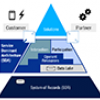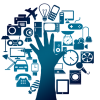Business Transformation Requires Transformational Leaders
Leadership and teaming skills are front and center in times of rapid change. Meet today’s constant disruption head on with expert guidance in leadership, business strategy, transformation, and innovation. Whether the disruption du jour is a digitally-driven upending of traditional business models, the pandemic-driven end to business as usual, or the change-driven challenge of staffing that meets your transformation plans—you’ll be prepared with cutting edge techniques and expert knowledge that enable strategic leadership.
Recently Published
In this Advisor, we present the approach taken to set a roadmap for the journey of the Hellenic Telecommunications Organization (OTE), the incumbent telecom operator in Greece, toward digital transformation.
In this on-demand webinar, Cutter Consortium Fellow, Steve Andriole, focuses on how to make digital transformation projects successful by assessing the methods, skills and support at your disposal.
Customer journeys, value chains, value streams, and business processes are four organizational views that tend to bring about questions and confusion. On the surface, each of these artifacts may appear to have some similar elements, such as the business vocabulary they use or the fact that they represent some concept of “flow.” However, as this Executive Update clarifies, all four views differ in both intention and representation and thus should be clearly differentiated from each other.
Today’s leaders are racing to reconfigure their organizations to be more adaptive and competitive. However, when looking for guidance on how to do that, they will discover two competing schools of thought in the Agile community: “First fix the culture” and “First fix the org structure.” In reality, this debate between a culture-first or structure-first strategy is misguided. Leaders need to encourage a conversation that incorporates both perspectives. Through this two-sided conversation, they can guide an organizational transition that is both meaningful and sustainable.
In this Advisor, we report on research carried out at the State Street/University College Cork Advanced Technology Centre in Cork, Ireland. The challenge we address in our work is how to leverage and nurture the diversity of the crowd while still ensuring the crowd behaves in a safe, responsible, and informed manner.
The insurance arena is undergoing an evolution through technological developments, demand changes for coverage, and risk perception. A dire need for change is evident when we look at large disasters that have the potential to cause harm to diverse communities over sizeable geographical areas
In this article, we reflect on the experiences gained in the digital transformation of a traditional insurance company in Germany.
Connected insurance, enabled by big data, the Internet of Things (IoT), and artificial intelligence (AI), is disrupting a major industry that is traditionally resistant to change. Insurance technology — or insurtech — is a vast field and incorporates the interconnected landscape of connected insurance with its three pillars: health, car, and home. Microinsurance comes as a transversal opportunity that can help close the protection gap on the one hand and allow carriers to propose customer-centric products and services aligned with client expectations and behavior on the other hand.















